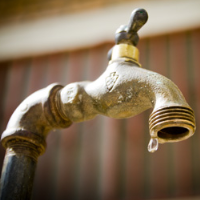“Highly Stressed” Central Valley Aquifer May Be Just Decades from Doom

The aquifer beneath California’s Central Valley did not make a new satellite study’s list of 13 “overstressed” groundwater sites around the world that are losing water at an enormous rate and not replenishing.
The Central Valley is replenishing a bit, so it is only “highly stressed,” according to research led by the University of California, Irvine (UCI). But that’s not good enough to avoid disaster in the state and nation’s real agricultural heartland.
Using available information from 1975 as a benchmark for change in the aquifer, the second of two studies (pdf) found that “usable groundwater . . . may be expended in a matter of decades given current rates of groundwater depletion” in the valley. California has amped up its depletion of groundwater since the drought began four years ago.
The researchers used data from NASA's two Gravity Recovery and Climate Experiment (GRACE) satellites, which gathered information about the 37 largest aquifers on the planet between 2003 and 2013. The satellites measure variations in the Earth’s gravitational pull and that data is used to calculate water mass changes beneath the surface by comparing water capture to depletion over time.
The first report (pdf) said 21 of the aquifers were losing more water than gaining and 16 were in positive territory. The eight worst were classified as overstressed and another five were considered “extremely” or “highly stressed.” All 13 were losing water rapidly, but the eight worst weren’t replenishing any of the supply.
“We know we're taking more than we're putting back in—how long do we have before we can't do that anymore?” researcher Alexandra Richey asked the Los Angeles Times and then answered her own question. “We don't know, but we keep pumping. Which to me is terrifying.”
The most stressed aquifers are in Saudi Arabia, India, Pakistan and northern Africa. Jay Famiglietti, principal investigator in the two studies, told the Huffington Post the 21 most-stressed aquifers were at a “tipping point.”
The researchers admitted that they were limited in their observations because they don’t have accurate onsite measurements of aquifer contents. Famiglietti, senior water scientist at NASA’s Jet Propulsion Laboratory, said the measurements could be made, but funding is lacking.
“The lack of ground-based measures of total storage will continue to prevent a full characterization of aquifer stress and resilience,” according to the report. The researchers said what little we do know about storage estimates is probably way too optimistic.
–Ken Broder
To Learn More:
A Third of the World’s Biggest Groundwater Basins Are in Distress (UCI News)
One-Third of the World's Largest Groundwater Sources Are in Serious Trouble: Study (by Hilary Hanson, Huffington Post)
Many of the World's Water Basins Are Being Depleted, Studies Find (by Rosanna Xia, Los Angeles Times)
California Tracks Water-Well Drilling but Doesn’t Share the Data (by Ken Broder, AllGov California)
Quantifying Renewable Groundwater Stress with GRACE (Study led by University of California, Irvine, Water Resources Research) (pdf)
Uncertainty in Global Groundwater Storage Estimates in a Total Groundwater Stress Framework (Study led by University of California, Irvine, Water Resources Research) (pdf)
- Top Stories
- Controversies
- Where is the Money Going?
- California and the Nation
- Appointments and Resignations
- Unusual News
- Latest News
- California Forbids U.S. Immigration Agents from Pretending to be Police
- California Lawmakers Urged to Strip “Self-Dealing” Tax Board of Its Duties
- Big Oil’s Grip on California
- Santa Cruz Police See Homeland Security Betrayal in Use of Gang Roundup as Cover for Immigration Raid
- Oil Companies Face Deadline to Stop Polluting California Groundwater




